
 1,001 GRE Practice Questions For Dummies Published by: John Wiley & Sons, Inc., 111 River Street, Hoboken, NJ 07030-5774,
1,001 GRE Practice Questions For Dummies Published by: John Wiley & Sons, Inc., 111 River Street, Hoboken, NJ 07030-5774, www.wiley.com Copyright 2015 by John Wiley & Sons, Inc., Hoboken, New Jersey Published simultaneously in Canada No part of this publication may be reproduced, stored in a retrieval system or transmitted in any form or by any means, electronic, mechanical, photocopying, recording, scanning or otherwise, except as permitted under Sections 107 or 108 of the 1976 United States Copyright Act, without the prior written permission of the Publisher. Requests to the Publisher for permission should be addressed to the Permissions Department, John Wiley & Sons, Inc., 111 River Street, Hoboken, NJ 07030, (201) 748-6011, fax (201) 748-6008, or online at http://www.wiley.com/go/permissions . Trademarks: Wiley, For Dummies, the Dummies Man logo, Dummies.com, Making Everything Easier, and related trade dress are trademarks or registered trademarks of John Wiley & Sons, Inc., and may not be used without written permission. All other trademarks are the property of their respective owners. John Wiley & Sons, Inc., is not associated with any product or vendor mentioned in this book. GRE is a registered trademark of Educational Testing Service (ETS).
This product is not endorsed or approved by ETS. LIMIT OF LIABILITY/DISCLAIMER OF WARRANTY: WHILE THE PUBLISHER AND AUTHOR HAVE USED THEIR BEST EFFORTS IN PREPARING THIS BOOK, THEY MAKE NO REPRESENTATIONS OR WARRANTIES WITH RESPECT TO THE ACCURACY OR COMPLETENESS OF THE CONTENTS OF THIS BOOK AND SPECIFICALLY DISCLAIM ANY IMPLIED WARRANTIES OF MERCHANTABILITY OR FITNESS FOR A PARTICULAR PURPOSE. NO WARRANTY MAY BE CREATED OR EXTENDED BY SALES REPRESENTATIVES OR WRITTEN SALES MATERIALS. THE ADVICE AND STRATEGIES CONTAINED HEREIN MAY NOT BE SUITABLE FOR YOUR SITUATION. YOU SHOULD CONSULT WITH A PROFESSIONAL WHERE APPROPRIATE. at 877-762-2974, outside the U.S. at 317-572-3993, or fax 317-572-4002. at 317-572-3993, or fax 317-572-4002.
For technical support, please visit www.wiley.com/techsupport . Wiley publishes in a variety of print and electronic formats and by print-on-demand. Some material included with standard print versions of this book may not be included in e-books or in print-on-demand. If this book refers to media such as a CD or DVD that is not included in the version you purchased, you may download this material at http://booksupport.wiley.com . For more information about Wiley products, visit www.wiley.com . Library of Congress Control Number: 2014954672 ISBN 978-1-118-82568-6 (pbk); ISBN 978-1-118-82580-8 (ebk); ISBN 978-1-118-82573-0 (ebk)
1,001 GRE Practice Questions For Dummies
Visit www.dummies.com/cheatsheet/1001GRE to view this book's cheat sheet.
- Table of Contents
Guide
Pages
Introduction
Welcome to 1,001 GRE Practice Questions For Dummies.
Dont take the Dummies thing personally youre obviously no dummy. You made it through high school with high enough grades and test scores to get into college. You then graduated to join the elite group of approximately 30 percent of U.S. citizens who hold bachelors degrees, and some of you even have masters degrees. And now youre about to take your education further. Between you and your goal is the GRE: a test designed solely to challenge your ability to remember everything youve forgotten since high school material you havent touched in years.
To clear this hurdle, you need some practice along with pointers of how best to answer the questions. This book provides that and more: It goes beyond providing relevant practice questions by showing simple and effective ways to solve the seemingly challenging GRE problems.
What Youll Find
The GRE practice problems in this book are divided into six chapters: three verbal, two math, and one writing. Questions are grouped by topic. If theres a topic that you struggle with, youll find a group of similar questions to practice and hone your skills. This book serves as an effective stand-alone refresher of GRE basics, or as an excellent companion to GRE For Dummies, 8th Edition, written by yours truly (with invaluable help from Joe Kraynak) and published by Wiley.
Either way, this book helps you identify subject areas you need to work on so that you can practice them until youre a pro, and thus prepare yourself for test day. If you get a problem wrong, dont just read the answer explanation and move on. Instead, come back to the problem and solve it again, this time avoiding the mistake that you made the first time. This is how you improve your skills and learn to solve the problems correctly and easily. Whatever you do, stay positive. The challenging problems in this book arent meant to discourage you.
Rather, theyre meant to show you how to solve them so that you can practice and master them.
How the Questions Are Organized
The test is divided into three main parts: verbal, math, and writing.Verbal
The verbal questions in this book cover the following topics:- Sentence completion: These questions have sentences with one, two, or three words missing, and you have to select the word or words that logically complete the sentence.
- Reading comprehension: The GRE gives you a reading passage along with two to five questions based on the passage. The questions challenge your ability to discern the purpose of the passage and the significance of the details.
- Argument analysis: The GRE provides a short argument in the form of a passage and then asks you to select an answer that would either strengthen or weaken the argument. You may also have to define the roles of bolded sentences or select a sentence that serves a specific purpose.
Math
The math questions in this book cover the following topics:
- Arithmetic: These questions are based on core arithmetic concepts, including prime numbers, absolute value, decimals, fractions, and ratios. Dont be fooled by the simple nature: these questions can be as challenging as any that you find on the GRE.
- Geometry: Geometry covers basic shapes, such as triangles, circles, and squares.
These questions also go into basic 3-D shapes, including cylinders and boxes, but no prisms, spheres, or cones. The GRE sticks to its limited scope of math concepts.
- Argument analysis: The GRE provides a short argument in the form of a passage and then asks you to select an answer that would either strengthen or weaken the argument. You may also have to define the roles of bolded sentences or select a sentence that serves a specific purpose.
- Algebra: These questions are extensions of arithmetic, going into exponents, square roots, and numeric sequences. They also explore variations of solving for x and linear equations having x and y.
- Word problems: No set of word problems is complete without the two trains coming from Chattanooga. These questions cover those, along with weighted averages, probability, Venn diagrams, permutations, and combinations.
- Graphs and data interpretation: The GRE problems feature variations of median, range, and standard deviation concepts. It also asks challenging tables and graphs questions where, like the reading comprehension, you are given a set of graphs along with three questions based on those graphs.
Next page
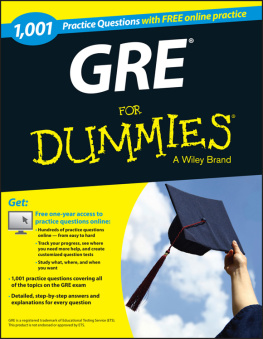
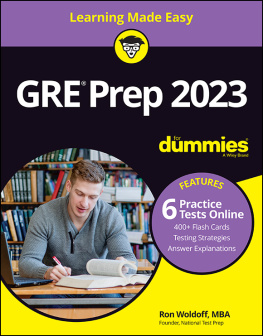
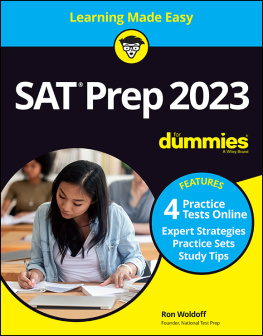


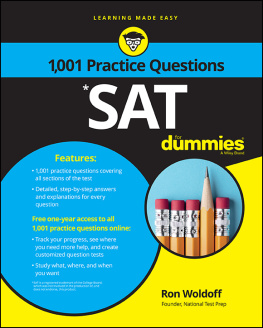
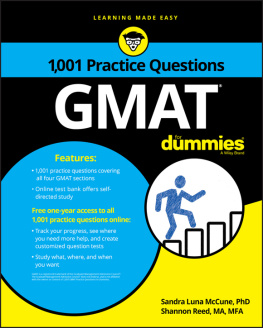
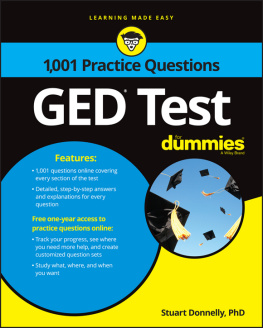
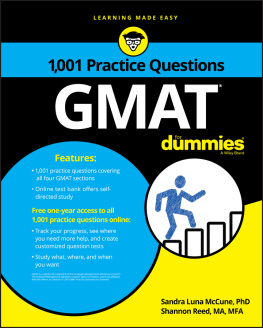
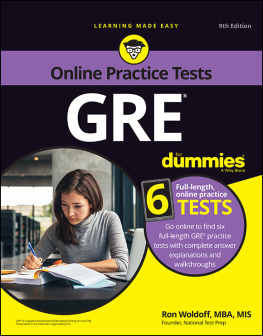
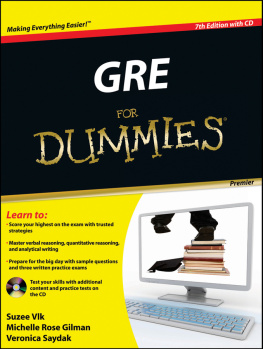

 1,001 GRE Practice Questions For Dummies Published by: John Wiley & Sons, Inc., 111 River Street, Hoboken, NJ 07030-5774,
1,001 GRE Practice Questions For Dummies Published by: John Wiley & Sons, Inc., 111 River Street, Hoboken, NJ 07030-5774,